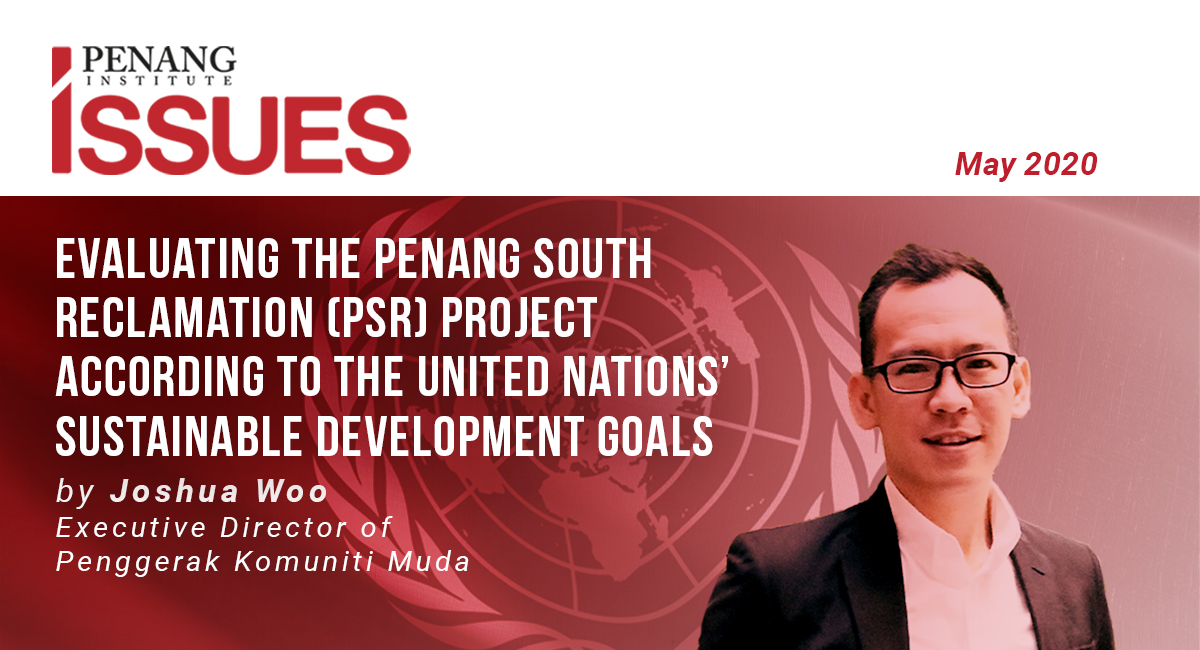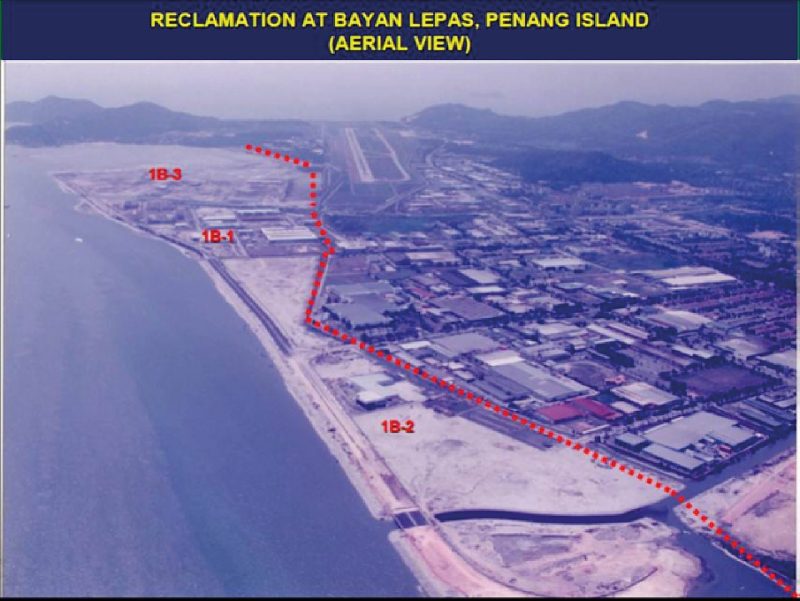Executive Summary
- This report is an evaluation of the proposed concept for the Penang South Reclamation (PSR) project, in relation to the United Nations’ 17 Sustainable Development Goals (SDGs)
- In terms of execution, the project aims to fulfil 11 SDGs, which impact society, the environment and the state economy. These SDGs are:
- No Poverty
- Decent Work and Economic Growth
- Industry, Innovation and Infrastructure
- Reduce Inequalities
- Sustainable Cities and Communities
- Responsible Consumption and Production
- Climate Action
- Life Below Water
- Life On Land
- Peace, Justice, and Strong Institutions
- Partnerships
- While the PSR project appears to be aligned to these SDGs, measures must be taken to mitigate its impact on the environment and affected populations, and not just a focus on economic prosperity
Introduction
The Penang South Reclamation (PSR) project has raised both excitement and weariness among those following its progress. Initially conceptualised as a financing model for the Penang Transport Master Plan (PTMP), the PSR involves the reclamation of 4,500 acres off the southern part of the island for the development of a platform conducive for Industry 4.0, based on smart city concepts. At the time of writing, five top world-class architects and town planners are competing to determine the best plan that will fulfil the objectives of the PSR project, which is meant to be a platform for economic transformation based on sustainable development principles. The winner is expected to be announced in May 2020 (Penang South Islands n.d.). But due to the spread of Covid-19, the final decision may be postponed.
The goal of this report is to evaluate the PSR project in light of the United Nations’ 17 Sustainable Development Goals (SDGs). Environmental concerns over the project will be addressed through the evaluation. Although the evaluation is a conceptual critique of the project, and may be viewed as premature, there are already conditions laid down by the National Physical Planning Council (NPPC) and the Penang state government in relation to sustainable development which allow for conceptual examination.
Sustainable Development Goals
To begin with, the 17 SDGs are as follows (United Nations n.d.):
- No Poverty
- Zero Hunger
- Good Health and Well-being
- Quality Education
- Gender Equality
- Clean Water and Sanitation
- Affordable and Clean Energy
- Decent Work and Economic Growth
- Industry, Innovation and Infrastructure
- Reduced Inequalities
- Sustainable Cities and Communities
- Responsible Consumption and Production
- Climate Action
- Life Below Water
- Life on Land
- Peace, Justice and Strong Institutions
- Partnerships
Eleven have immediate relevance to the PSR project, which will be discussed in further detail. The PSR will be examined in relation to these 11 SDGs, categorised into “People”, “Planet” and “Prosperity”: the three main themes of sustainable development (Roorda et al, 2017).
People
Relevant Goals:
- Reduce Inequalities (SDG10)
- Sustainable Cities and Communities (SDG11)
- Responsible Consumption and Production (SDG12)
- Peace, Justice, and Strong Institutions (SDG16)
- Partnerships (SDG17)
The mean monthly gross income of the fishing community in the PSR-impact zone is RM1,989.50 (ranging from RM500 to RM9,000), while Penang’s mean household income is RM6,771. (Kerajaan Negeri Pulau Pinang 2019a; Ong & Tan 2017). One of PSR’s aims is to bring economic opportunities that will uplift the income of fisherfolk and provide high-paying jobs for the community in the area, thus closing the income gap between them and the average Penangite. A key necessity is creating new economic opportunities on-site so that young people will not need to migrate or move away to pursue their careers, thus reducing inequalities and sustaining the local community (SDG10 and SDG11). Moreover, the PSR’s impact on fisheries should not be exaggerated, since less than 20% of the fishing vessels in Penang operate in the area earmarked for PSR’s reclamation work (Mok 2019a). Affected fishermen will also receive compensation through the Fishermen Taskforce for the loss of income due to the project.
Penang contributes 3% of the national captured fish supply, landed from 2,268 state-registered vessels out of a total of 34,103 vessels nationwide (Lembaga Kemajuan Ikan Malaysia 2018, p.13). This shows that Penang is not a significant player in the national fishery sector. Nonetheless, overfishing caused by an increasing number of fishermen is a real concern, leading the state fishery authority to reduce fishing vessel licenses by 30% in 2015 (Vaghefi 2017). However, overfishing persists since unlicensed vessels continue to operate. Practical alternatives, such as aquaculture, are a more sustainable production method.
In contrast, aquaculture yields 50% of Penang’s seafood production, the highest in Malaysia. In 2018 Penang produced 47,742 tonnes of aquaculture products valued at RM1.67bil. (Nambiar 2019). One of PSR’s mitigation measures is to help fishermen transition into this lucrative and more sustainable trade. Furthermore, the installation of artificial reefs and aggregating devices would replenish natural marine stocks in line with SDG11 and SDG12. For these and other reasons, more than 50% of the fishermen have agreed to the PSR project (Looi 2019).
So far, the preparation for PSR has been fairly successful at strengthening institutions (SDG16) and creating extensive partnerships (SDG17). The process of obtaining approval involved a transparent and competitive procurement process, conducted via an open tender in the form of a request-for-proposals (RFP) which received 55 interested inquiries and six submissions. This procurement method is professionally and globally recognised and used as “open tender” by international bodies like the United Nations and World Bank (Woo 2019a). The proposals were independently appraised by KPMG before a recommendation was made.
Following that, more than 1,000 review and engagement sessions with 17,000 participants took place over several years (Woo 2019b). Two engagement centres (Pusat Perkhidmatan Setempat Nelayan) managed by full-time staff were established along the PSR coast to reach out to the residents and fishing community since 2016 (Woo 2019c). An open tender through a master design competition was launched in late 2019, calling for top urban planners and architects to submit their best sustainable development concepts for the PSR (The Star 2019). The state government institutions adhered to professional standards throughout the process.
Planet
Relevant Goals:
- Climate Action (SDG13)
- Life Below Water (SDG14)
- Life On Land (SDG15)
PSR’s impact on the present environment is one major concern. The current beach, seabed, ocean and the surrounding of the PSR area are inhabited and not pristine. Pockets of fishing villages and squatters have been around for decades. The lack of proper sewage filtration system, loose enforcement and the absence of environmental concerns have caused localised pollution. The Social Impact Assessment showed that the marine catch has dropped 58% compared to 10 years prior (Mok 2019a).
As noted above, the practice of overfishing has been destroying marine lives. Fishermen would rather empty the ocean than to moderate their catch. This happened very recently in March 2020, when an increased concentration of marine chlorophyll caused an increase in local fish populations (Zain 2020; Lo 2020). Subsequent overfishing (90% more than usual) meant that their catch had to be sold as low as 50 cents per kilogramme instead of the usual RM5. Some fishermen even gave away their catch for free due to oversupply.
Besides overfishing, marine ecology is also severely impacted by pollution from the fishing sector. The biggest source of marine plastic pollution is discarded fishing equipment – more than 640,000 tonnes of fishing gear is dumped into the sea every year (Laville 2019). Numerous protected marine animals have been killed, including turtles. It is estimated that 4,600 turtles are killed in the US waters a year, 16,000 in South America by nets belonging to coastal small-scale fishermen and 4,500 off the coast of Sabah (Law 2019; Barnes 2018). A loggerhead turtle in Penang was caught in a fishing net in September 2019. It was rescued and rehabilitated, but many others are not that lucky (Mok 2019b). The fishing sector exerts significant stress on the environment, therefore better regulation and marine product cultivation are needed as alternative, which is a change that PSR can bring.
Using previous reclamation projects in Penang such as Straits Quay and Karpal Singh Drive as examples, development can encourage better environmental care. Generally, the natural environment occupied by a community with higher income is better cared for. A study based on 171 countries over the period of 1960 to 2010 has shown that environmental degradation increases to a turning point where per capita income exceeds US$30,000 and then decreases (Uchiyama 2016). This phenomenon is known as “Environmental Kuznets Curve” (Özcan & Öztürk 2019). By developing the area holistically through better jobs and increased liveability, the community will have the capacity to better care for “life below water” (SDG14) and “life on land” (SDG15).
The NPPC has estimated that the PSR will generate 3.2 million tonnes of carbon emissions per annum, and recommended a targeted reduction of 40% to 1.9 million tonnes. By incorporating improved carbon sequestration methods (e.g. CarbFix’s process of turning carbon into deep underground rock) and more effective carbon capture (e.g. the amount of carbon captured by a Carbon Engineering plant is equivalent to 40 million trees), the amount will be reduced further. Through such methods, actual carbon emissions will be far below the initial estimate.
Furthermore, reclamation when done right is a widely recognised climate change adaptation method. To adapt to rising sea levels, the Netherlands – much of it below sea level – has reclaimed land as polders; Singapore expects to spend RM300bil on reclamation projects; and the Maldives has started reclaiming land (Tang, 15 September 2019; Mohan, 18 August 2019; Brown, 20 September 2019; Van Oord n.d.). In a report about oceans and the cryosphere published in 2019, the United Nations’ Intergovernmental Panel on Climate Change (IPCC) remarked that reclamation is an advance measure to counter sea level rise in consideration of “land scarcity, population pressure and extreme events” and can be “an opportunity to support and fund adaptation” (IPCC, 2019a). The panel also noted that “land reclamation is a mature and effective technology which can provide predictable levels of safety”. In a separate report on climate change and land, also published in 2019, IPCC listed reclamation as an option that provides “multiple ecosystem services and functions” (IPCC, 2019b). The PSR has consulted the IPCC’s Fifth Assessment Report, particularly with respect to rising sea levels, to ensure best knowledge and practices will be applied in the project (Dermawan 2019). The PSR is thus conceptually aligned to SDG13’s emphasis on climate action.
Prosperity
Relevant Goals:
- No Poverty (SDG1)
- Decent Work and Economic Growth (SDG8)
- Industry, Innovation and Infrastructure (SDG9)
SDG1, SDG8 and SDG9 are interconnected in the sense that economic development contributes to long-term poverty alleviation. Welfare aid can only provide short-term relief.
Penang’s gross domestic product (GDP), GDP per capita and poverty reduction have seen significant improvements over the past four decades (see Table 1). Since the 1970s, the state has successfully transitioned from an import-substituting industrialisation framework into an export-oriented economy primarily based on electrical and electronics (E&E) manufacturing (Koay and Wong 2019). Clusters of development are built on reclaimed land (Chet Singh 2019, p.72) including many present popular infrastructure, industrial, commercial, residential and leisure places such as parts of the Bayan Lepas Free Industrial Zone, Straits Quay, Gurney Drive, Weld Quay, Tun Dr. Lim Chong Eu Expressway, Queensbay Mall, Karpal Singh Drive and the new Batu Kawan township (See Figures 1 and 2).
Table 1: Penang’s GDP, GDP Per Capita, Poverty Rate, Mean Monthly Gross Household Income, and Population in 1970 and 2014

Figure 1: Penang’s Geography Today
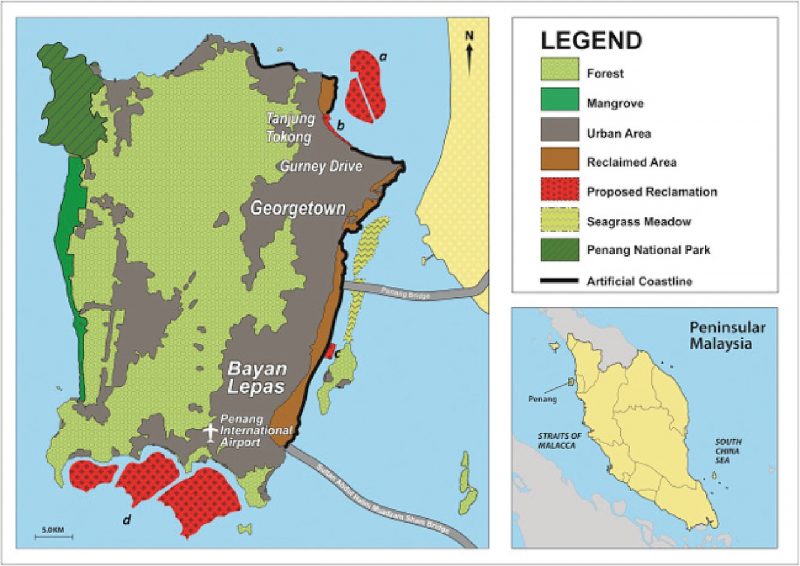
Figure 2: Reclaimed Land within the Bayan Lepas Free Industrial Zone, the Epicentre of Penang’s E&E Sector
Penang’s economy was growing very fast from the 1970s until the emergence of cheaper economic alternatives such as China, neighbouring countries and other Malaysian states from the late 1990s onwards. Domestically, the limited talent pool, lack of innovation, and suboptimal infrastructural support in Penang have reduced its capacity from transitioning into an advanced innovative technological hub based on its E&E ecosystem. The result was a decline in GDP growth rate until the change of state government in 2008 (See Table 2).
Table 2: Penang’s GDP Growth Rate, 1975-2015

Post-2008, there was a strong focus on creating extensive infrastructure to retain and develop talent, and also to create a fertile built environment for an innovative economy to flourish. Among the initiatives to reboot the state’s competitive advantages were the transformation of Penang International Sports Arena (PISA) into the Subterranean Penang International Convention and Exhibition Centre (SPICE), the development of the Penang Tourism Master Plan, providing seed funds to build ESCAPE Theme Park, developing the Batu Kawan township, launching the annual George Town Festival and its spin-offs, building the PTMP, developing Gurney Wharf and finally embarking on the PSR project.
PricewaterhouseCoopers has projected that PSR would create and support more than 300,000 jobs, provide business opportunities to 24,000 small-medium-enterprises, and add more than RM40bil to GDP per year during reclamation and dredging with another 20% annual contribution to GDP after project completion in 2050 (Lim 2016). In a separate estimate, the PSR will generate RM70bil funds for economic development of Penang for the next three decades (Tan 2019).
Conclusion
Since the detailed design of the PSR will only be known after the master design competition is completed, we have so far evaluated the project conceptually with the 11 relevant SDGs. The PSR project appears to be aligned with these SDGs. Other SDGs are not directly pertinent at the present stage. When the project begins, mitigation measures must be taken to reduce impact as listed in the environmental impact assessment. As long as PSR follows a sustainable development framework, the project would reap long-term benefits for the people, proper development with the planet in mind, and increased prosperity for Penang.
References
Barnes, Tom. 2018. ‘Thousands of turtles killed each year by small-scale fisheries, scientists warn.’ The Independent. 5 June. Retrieved from https://www.independent.co.uk/environment/turtles-killed-fisheries-fishing-nets-south-america-endangered-prodelphinus-a8383526.html
Brown, Sally. 2019. ‘Coastal communities highly threatened by rising sea-levels, even with climate change mitigation.’ 20 September. Retrieved from https://www.southampton.ac.uk/news/2019/ 09/sea-levels-coastal-communities.page
Chee, Su Yin; Othman, Abdul Ghapar; Sim, Yee; Adam, Nabilah & Firth, Louise. 2017. ‘Land reclamation and artificial islands: Walking the tightrope between development and conservation.’ Global Ecology and Conservation, vol.12. pp.80-95. Retrieved from https://www. researchgate.net/figure/Map-showing-present-distribution-as-of-2017-of-natural-habitats-reclaimed-land-and_fig2_320152008
Chet Singh. 2019. ‘Penang Development Corporation and Penang’s Catalytic Transformation.’ In Chet Singh; Rajah Rasiah; and Wong Yee Tuan (Eds.), From Free Port to Modern Economy: Economic Development and Social Change in Penang, 1969 to 1990, (pp.37-56). Malaysia: Penang Institute and Yusof Ishak Institute.
Chet Singh; Rajah Rasiah; and Wong Yee Tuan. 2019. From Free Port to Modern Economy: Economic Development and Social Change in Penang, 1969 to 1990. Malaysia: Penang Institute and Yusof Ishak Institute.
Department of Statistics. 2017. Report of Household Income and Basic Amenities Survey 2016. 9 October. Retrieved from https://www.dosm.gov.my/v1/index.php?r=column/cthemeByCat&cat=120&bul_id=RUZ5REwveU1ra1hGL21JWVlPRmU2Zz09&menu_id=amVoWU54UTl0a21NWmd hMjFMMWcyZz09
Dermawan, Audrey. 2019. ‘Reclamation will follow modern engineering design, best practices’. New Straits Times. 20 July. Retrieved from https://www.nst.com.my/news/nation/2019/07/505769/reclam ation-will-follow-modern-engineering-design-best-practices
Intergovernmental Panel on Climate Change. 2019a. Special Report On The Ocean and Cryosphere In A Changing Climate. Retrieved from https://www.ipcc.ch/srocc/chapter/chapter-4-sea-level-rise -and-implications-for-low-lying-islands-coasts-and-communities/
—. 2019b. Special Report On Climate Change and Land. Retrieved from https://www.ipcc.ch/srccl/chapter/summary-for-policymakers/
Kerajaan Negeri Pulau Pinang. 2019a. The Proposed Reclamation & Dredging Works for the Penang South Reclamation (PSR): Environmental Impact Assessment (Revision 2), vol.1. March. Malaysia: Kerajaan Negeri Pulau Pinang.
— . 2019b. The Proposed Reclamation & Dredging Works for the Penang South Reclamation (PSR): Social Impact Assessment (Revision 2). April. Malaysia: Kerajaan Negeri Pulau Pinang.
Koay, Su Lyn and Wong, Yee Tuan. 2019. ‘From Munro to Nathan: The Rise of a Modern Economy in Penang.’ In Chet Singh; Rajah Rasiah; and Wong Yee Tuan (Eds.), From Free Port to Modern Economy: Economic Development and Social Change in Penang, 1969 to 1990, (pp.37-56). Malaysia: Penang Institute and Yusof Ishak Institute.
Law Yao-Hua. 2019. ‘The Tough Sell of Turtle-Saving Tech.’ Hakai Magazine. 7 May. Retrieved from https://www.hakaimagazine.com/features/tough-sell-of-turtle-saving-tech/
Laville, Sandra. 2019. ‘Dumped fishing gear is biggest plastic polluter in ocean, finds report.’ The Guardian. 6 November. Retrieved from https://www.theguardian.com/environment/ 2019/nov/06/dumped-fishing-gear-is-biggest-plastic-polluter-in-ocean-finds-report
Lim, Cavina. 2016. ‘Fishermen protest against PSR project’. The Star. 18 December. Retrieved from https://www.thestar.com.my/news/nation/2016/12/18/reclamation-will-affect-livelihood-says-group/
Lo, Tern Chern. 2020. ‘Kembong thriving up north.’ The Star. 6 November. Retrieved from https://www.thestar.com.my/metro/metro-news/2020/03/31/kembong-thriving-up-north
Looi, Sue Chern. 2019. ‘More than 50% of fishermen support reclamation project, claims Penang exco.’ The Malaysian Insights. 3 May. Retrieved from https://www.themalaysianinsight. com/s/151925
Mohan, Matthew. 2019. ‘NDR 2019: It could cost S$100 billion or more to protect Singapore against rising sea levels, PM Lee says.’ Channel News Asia. 18 August. Retrieved from https://www.channelnewsasia.com/news/singapore/ndr-2019-singapore-climate-change-costs-rising-sea-levels-11819402
Mok, Opalyn. 2019a. ‘Under 20pc of boats still fish in site marked for reclamation, says Penang exco.’ Malay Mail. 24 October. Retrieved from https://www.malaymail.com/news/malaysia/2019/10/24/under-20pc-of-boats-still-fish-in-site-marked-for-reclamation-says-penang-e/1803276
— . 2019b. Endangered loggerhead turtle netted in Penang returned to sea. The Malay Mail. 24 October. Retrieved from https://www.malaymail.com/news/malaysia/2019/10/24/endangered-loggerhead-turtle-netted-in-penang-returned-to-sea/1803270
Nambiar, Predeep. 2019. ‘As fish stocks dip, deputy minister tells fishermen to take up aquaculture.’
Free Malaysia Today. 9 September. Retrieved from https://www.freemalaysiatoday.com/category/nation/2019/09/09/as-fish-stocks-dip-deputy-minister-tells-fisherm en-to-take-up-aquaculture/
National Higher Education Research Institute. 2010. The State of Penang, Malaysia: Self-Evaluation Report. OECD Reviews of Higher Education in Regional and City Development. Retrieved from https://www.oecd.org/countries/malaysia/45496343.pdf
Ong, Kian Ming & Tan, Nick Beng Teong. 2017. Penang’s Economy is Healthy and Strong, with Incomes Rising and Inequality Decreasing. Malaysia: Penang Institute. 8 November. Retrieved from https://penanginstitute.org/publications/issues/1023-penang-s-economy-is-healthy-and-strong-with-i ncomes-rising-and-inequality-decreasing/
Özcan, Burcu & Öztürk, Ilhan. 2019. Environmental Kuznets Curve (EKC): A Manual. United
Kingdom: Academic Press, Elsevier.
Pejabat Setiausaha Kerajaan Negeri Pulau Pinang and Penang Institute. 2015. Penang In Numbers 2014/2015. Retrieved from https://www.penang.gov.my/images/penerbitan/sosioekonomi /Penang-in-Numbers-2014-2015.pdf
Penang South Islands. n.d. “International masterplan Design Competition.” Penang South Islands.
Accessed 27 April, 2020. https://pg-mdc.com/.
Roorda, Niko; Corcoran, Peter Blaze; Weakland, Joseph P. 2017. Fundamentals of Sustainable Development, second edition. Routledge.
Tan, David. 2019. ‘Islands to drive state economy.’ The Star. 16 April. Retrieved from https://www.thestar.com.my/news/nation/2019/04/16/islands-to-drive-state-economy/
Tang, See Kit. 2019. ‘Fending off the floods – 5 things to know about polders and how they could work in Singapore.’ Channel News Asia. 15 September. Retrieved from https://www.channelnewsasia.com/news/specialreports/climate-change-special/netherlands-climate-change-5-things-polders-sea-level-11903152
The Star. 2019. ‘27 shortlisted in masterplan contest.’ The Star. 11 December. Retrieved from https://www.thestar.com.my/metro/metro-news/2019/12/11/27-shortlisted-in-masterplan-contest
Uchiyama, Katsuhisa. 2016. Environmental Kuznets Curve Hypothesis and Carbon Dioxide Emissions. Japan: Springer.
United Nations. n.d. “Sustainable Development Goals.” United Nations Sustainable Development Goals. Accessed 2020 April, 27. https://www.un.org/sustainabledevelopment/sustainable -development-goals/.
Vaghefi, Negin. 2017. Penang’s Aquaculture Industry Holds Great Economic Potential. 29 August. Malaysia: Penang Institute. Retrieved from https://penanginstitute.org/publications/ issues/1005-penang-s-aquaculture-industry-holds-great-economic-potential/
Van Oord. n.d. “Creating more land in the Maldives.” Van Oord. Accessed 2020 April, 27.
https://www.vanoord.com/activities/creating-more-land-maldives.
Woo, Joshua. 2019a. ‘Is ‘open Request for Proposal’ an open tender?’ The Malay Mail. 28 February. Retrieved from https://www.malaymail.com/news/what-you-think/2019/02/28/is-open-request -for-proposal-an-open-tender-joshua-woo/1727855
— . 2019b. ‘Reclaimed islands will be owned by Penang govt.’ Free Malaysia Today. 31 March. Retrieved from https://www.freemalaysiatoday.com/category/opinion/2019/03/31/reclaimed-islands -will-be-owned-by-penang-govt/
— . 2019c. ‘Penang transport plan uses competitive open RFP.’ The Malay Mail. 29 May. Retrieved from https://www.malaymail.com/news/what-you-think/2019/05/29/penang-transport-plan-uses-competitive-open-rfp-joshua-woo/1757439
Zaim, Ibrahim. 2020. ‘Ikan Kembung berlambak; pengguna gembira, nelayan berduka.’ The Malaysian Insight. 15 March. Retrieved from https://www.themalaysianinsight.com/bahasa/s/228593
Managing Editor:Ooi Kee Beng, Editorial Team: Alexander Fernandez, William Tham and Nur Fitriah (designer)
You might also like:
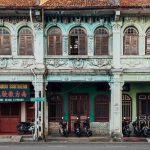
Key Issues to Consider in Heritage Preservation

Malaysia’s Northern States: Improving Competitive Advantages and Industrial Growth

Breaking Old Habits is Vital for Malaysia’s Mainstream Newspapers
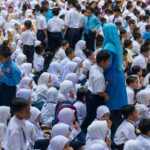
National Unity 2.0: A Necessary Upgrade and Revival in Malaysia’s Nation-building Ambitions and Appr...

Picking the Brains of GLC Heads: Policy Priorities for Penang in the Coming Decade

